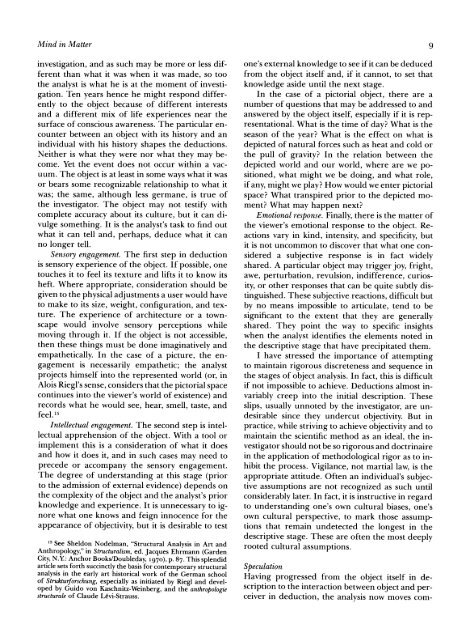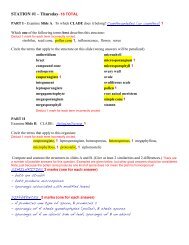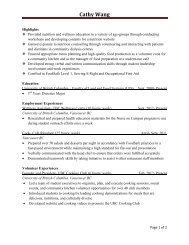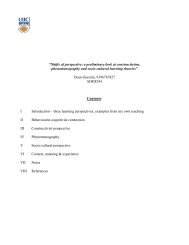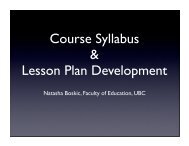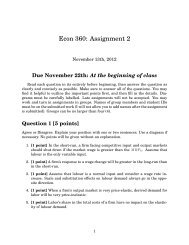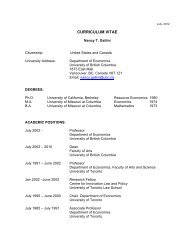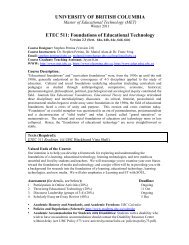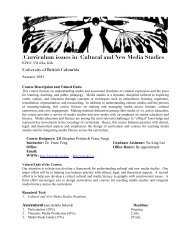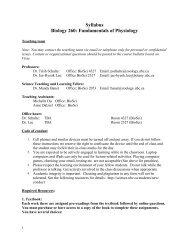Mind in Matter: An Introduction to Material Culture ... - UBC Blogs
Mind in Matter: An Introduction to Material Culture ... - UBC Blogs
Mind in Matter: An Introduction to Material Culture ... - UBC Blogs
You also want an ePaper? Increase the reach of your titles
YUMPU automatically turns print PDFs into web optimized ePapers that Google loves.
<strong>M<strong>in</strong>d</strong> <strong>in</strong> <strong>Matter</strong><strong>in</strong>vestigation, and as such may be more or less differentthan what it was when it was made, so <strong>to</strong>othe analyst is what he is at the moment of <strong>in</strong>vestigation.Ten years hence he might respond differently<strong>to</strong> the object because of different <strong>in</strong>terestsand a different mix of life experiences near thesurface of conscious awareness. The particular encounterbetween an object with its his<strong>to</strong>ry and an<strong>in</strong>dividual with his his<strong>to</strong>ry shapes the deductions.Neither is what they were nor what they may become.Yet the event does not occur with<strong>in</strong> a vacuum.The object is at least <strong>in</strong> some ways what it wasor bears some recognizable relationship <strong>to</strong> what itwas; the same, although less germane, is true ofthe <strong>in</strong>vestiga<strong>to</strong>r. The object may not testify withcomplete accuracy about its culture, but it can divulgesometh<strong>in</strong>g. It is the analyst's task <strong>to</strong> f<strong>in</strong>d outwhat it can tell and, perhaps, deduce what it canno longer tell.Sensory engagement. The first step <strong>in</strong> deductionis sensory experience of the object. If possible, one<strong>to</strong>uches it <strong>to</strong> feel its texture and lifts it <strong>to</strong> know itsheft. Where appropriate, consideration should begiven <strong>to</strong> the physical adjustments a user would have<strong>to</strong> make <strong>to</strong> its size, weight, configuration, and texture.The experience of architecture or a <strong>to</strong>wnscapewould <strong>in</strong>volve sensory perceptions whilemov<strong>in</strong>g through it. If the object is not accessible,then these th<strong>in</strong>gs must be done imag<strong>in</strong>atively andempathetically. In the case of a picture, the engagementis necessarily empathetic; the analystprojects himself <strong>in</strong><strong>to</strong> the represented world (or, <strong>in</strong>Alois Riegl's sense, considers that the pic<strong>to</strong>rial spacecont<strong>in</strong>ues <strong>in</strong><strong>to</strong> the viewer's world of existence) andrecords what he would see, hear, smell, taste, andfeel. 15Intellectual engagement. The second step is <strong>in</strong>tellectualapprehension of the object. With a <strong>to</strong>ol orimplement this is a consideration of what it doesand how it does it, and <strong>in</strong> such cases may need <strong>to</strong>precede or accompany the sensory engagement.The degree of understand<strong>in</strong>g at this stage (prior<strong>to</strong> the admission of external evidence) depends onthe complexity of the object and the analyst's priorknowledge and experience. It is unnecessary <strong>to</strong> ignorewhat one knows and feign <strong>in</strong>nocence for theappearance of objectivity, but it is desirable <strong>to</strong> test15See Sheldon Nodelman, "Structural <strong>An</strong>alysis <strong>in</strong> Art and<strong>An</strong>thropology," <strong>in</strong> Structuralism, ed. Jacques Ehrmann (GardenCity, N.Y: <strong>An</strong>chor Books/Doubleday, 1970), p. 87. This splendidarticle sets forth succ<strong>in</strong>ctly the basis for contemporary structuralanalysis <strong>in</strong> the early art his<strong>to</strong>rical work of the German schoolof Strukturforschung, especially as <strong>in</strong>itiated by Riegl and developedby Guido von Kaschnitz-We<strong>in</strong>berg, and the anthropologiestructurale of Claude Levi-Strauss.one's external knowledge <strong>to</strong> see if it can be deducedfrom the object itself and, if it cannot, <strong>to</strong> set thatknowledge aside until the next stage.In the case of a pic<strong>to</strong>rial object, there are anumber of questions that may be addressed <strong>to</strong> andanswered by the object itself, especially if it is representational.What is the time of day? What is theseason of the year? What is the effect on what isdepicted of natural forces such as heat and cold orthe pull of gravity? In the relation between thedepicted world and our world, where are we positioned,what might we be do<strong>in</strong>g, and what role,if any, might we play? How would we enter pic<strong>to</strong>rialspace? What transpired prior <strong>to</strong> the depicted moment?What may happen next?Emotional response. F<strong>in</strong>ally, there is the matter ofthe viewer's emotional response <strong>to</strong> the object. Reactionsvary <strong>in</strong> k<strong>in</strong>d, <strong>in</strong>tensity, and specificity, butit is not uncommon <strong>to</strong> discover that what one considereda subjective response is <strong>in</strong> fact widelyshared. A particular object may trigger joy, fright,awe, perturbation, revulsion, <strong>in</strong>difference, curiosity,or other responses that can be quite subtly dist<strong>in</strong>guished.These subjective reactions, difficult butby no means impossible <strong>to</strong> articulate, tend <strong>to</strong> besignificant <strong>to</strong> the extent that they are generallyshared. They po<strong>in</strong>t the way <strong>to</strong> specific <strong>in</strong>sightswhen the analyst identifies the elements noted <strong>in</strong>the descriptive stage that have precipitated them.I have stressed the importance of attempt<strong>in</strong>g<strong>to</strong> ma<strong>in</strong>ta<strong>in</strong> rigorous discreteness and sequence <strong>in</strong>the stages of object analysis. In fact, this is difficultif not impossible <strong>to</strong> achieve. Deductions almost <strong>in</strong>variablycreep <strong>in</strong><strong>to</strong> the <strong>in</strong>itial description. Theseslips, usually unnoted by the <strong>in</strong>vestiga<strong>to</strong>r, are undesirables<strong>in</strong>ce they undercut objectivity. But <strong>in</strong>practice, while striv<strong>in</strong>g <strong>to</strong> achieve objectivity and <strong>to</strong>ma<strong>in</strong>ta<strong>in</strong> the scientific method as an ideal, the <strong>in</strong>vestiga<strong>to</strong>rshould not be so rigorous and doctr<strong>in</strong>aire<strong>in</strong> the application of methodological rigor as <strong>to</strong> <strong>in</strong>hibitthe process. Vigilance, not martial law, is theappropriate attitude. Often an <strong>in</strong>dividual's subjectiveassumptions are not recognized as such untilconsiderably later. In fact, it is <strong>in</strong>structive <strong>in</strong> regard<strong>to</strong> understand<strong>in</strong>g one's own cultural biases, one'sown cultural perspective, <strong>to</strong> mark those assumptionsthat rema<strong>in</strong> undetected the longest <strong>in</strong> thedescriptive stage. These are often the most deeplyrooted cultural assumptions.SpeculationHav<strong>in</strong>g progressed from the object itself <strong>in</strong> description<strong>to</strong> the <strong>in</strong>teraction between object and perceiver<strong>in</strong> deduction, the analysis now moves com-9


